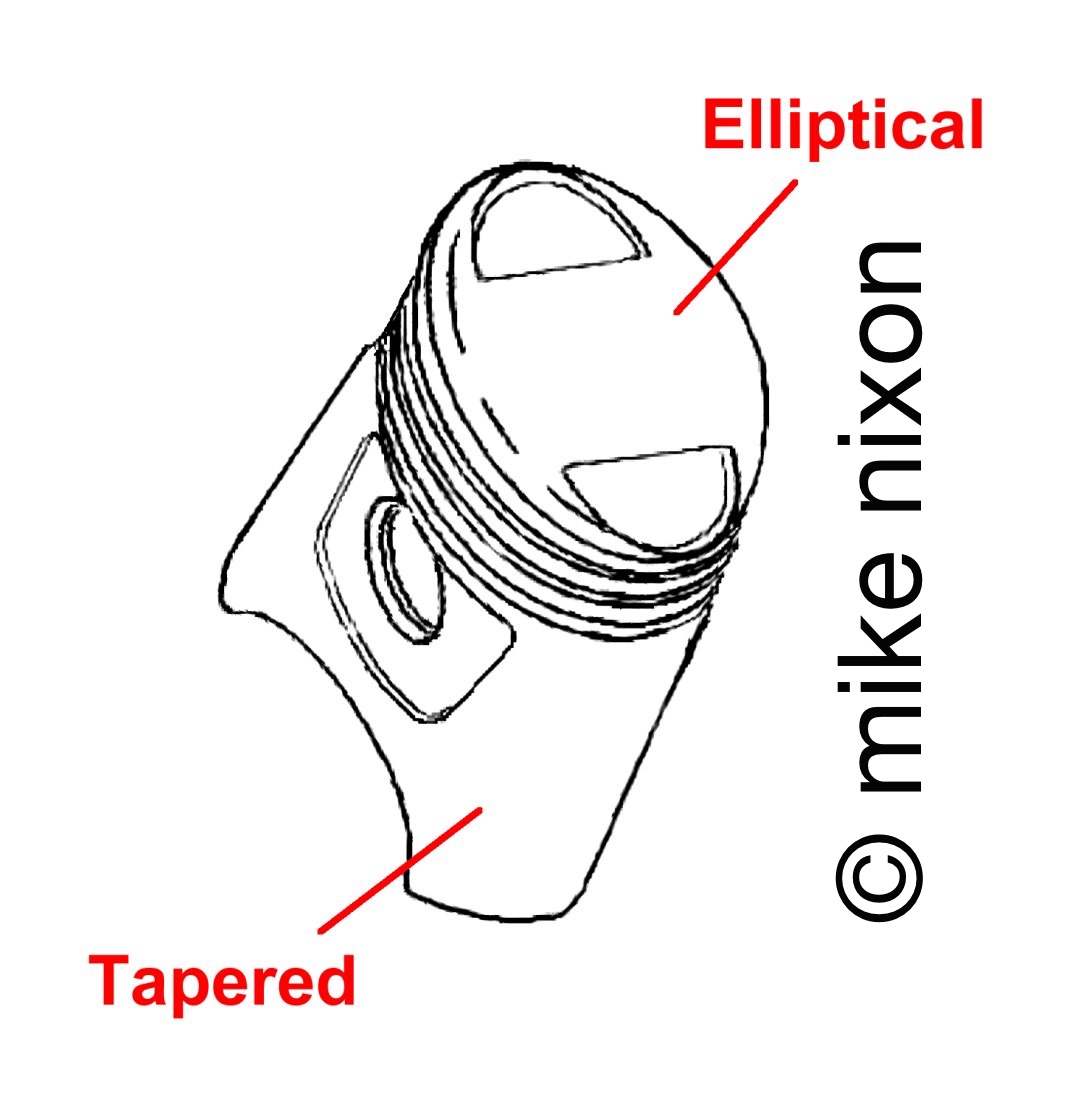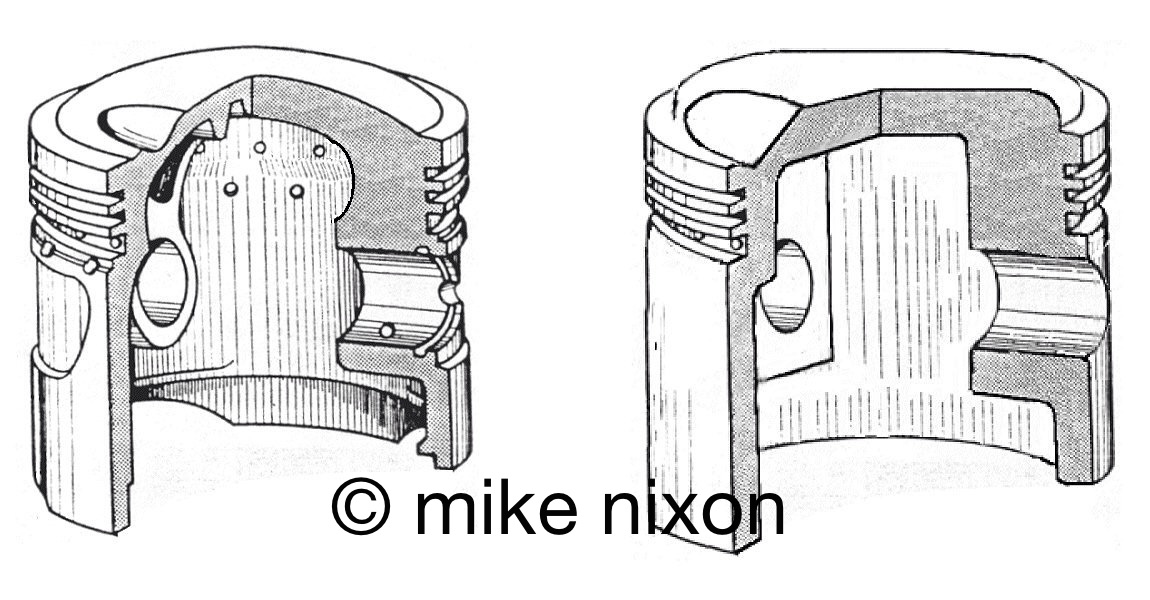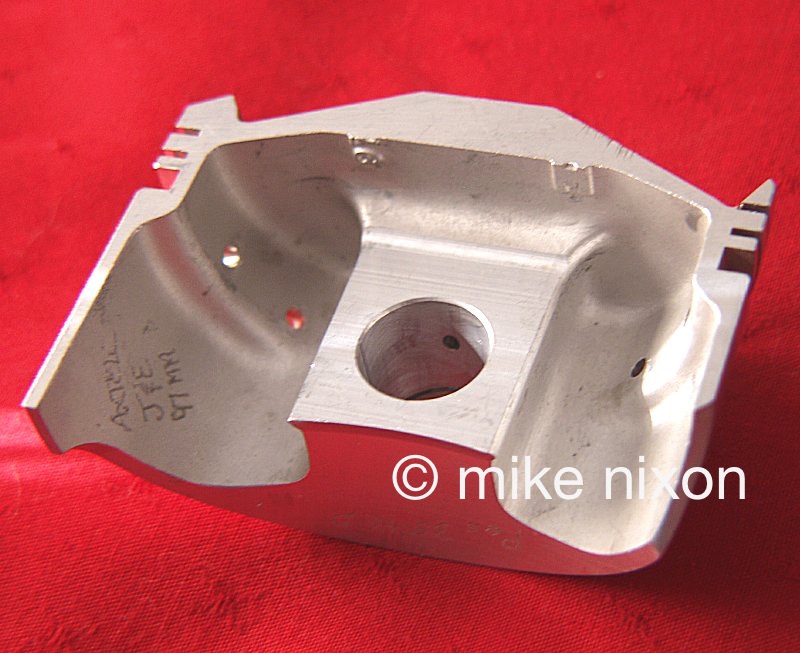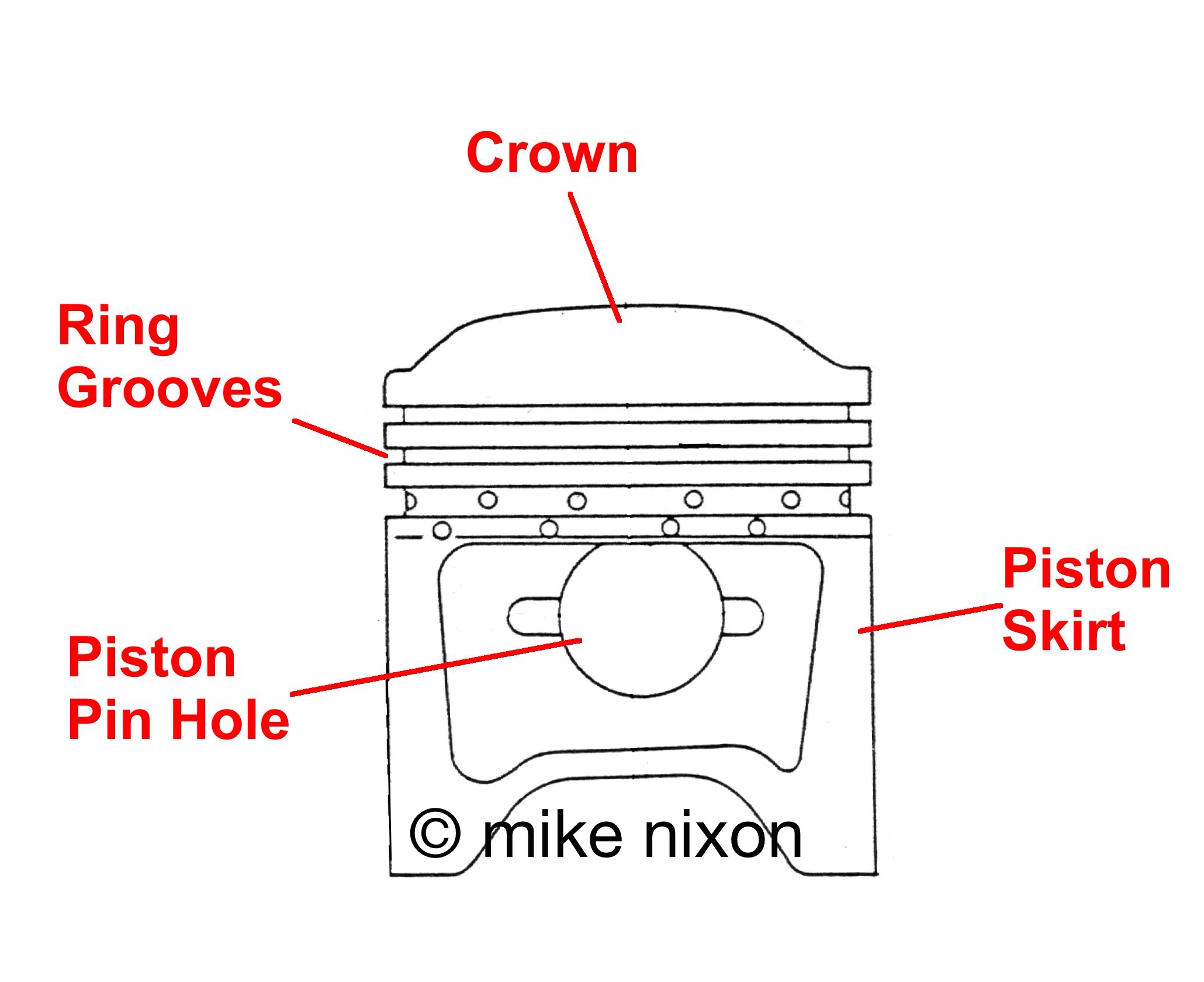Piston basics
The piston is under-appreciated, for sure. It may be the hardest-working part in the internal combustion engine.
The piston's roles
The piston is a bearing, receiving loads from combustion and transferring them straight to the connecting rod and to the crankshaft. The piston is also a seal, as it seals combustion's forces and compression's trapped air. In addition the piston is a heat conductor, transferring some of the cylinder's heat to the outside. In fact, nearly 80 percent of the cylinder's excess heat is drawn away by just the piston's rings.
The piston's parts
The piston's top or crown takes the brunt of combustion's forces and heat. Consequently, it's nearly the hottest part of the engine. It must therefore be thick enough to not collapse or melt. The precisely-manufactured ring groove accepts the piston ring. Harmonics cause the ring to rotate as the piston goes up and down in the cylinder. This helps the groove stay clean of carbon and ensures uniform ring and cylinder sealing. The solid pieces between the grooves are called ring lands, just as in a gun barrel. They support the shock loads the rings receive during combustion. Next is the piston pin hole. This hole accepts a pin that connects the piston to the connecting rod. In road-going engines the hole is offset from the piston's center slightly so that when the piston and rod reach TDC, they do so at slightly different times. This spreads the shock loads, easing stresses on the connecting rod, and as a bonus, eliminates "piston slap". The pin rotates against both piston and connecting rod in most Honda engines, unlike automotive practice in which the pin is pressed into the connecting rod. Surrounding the hole are pin bosses, thick masses of metal that support the pin. These bosses are actually the thickest and most massive parts of the piston, and with the crown, the next thickest part, largely determine the shape the piston will take when hot, as the piston expands the most in these thicker areas. Lastly, the piston skirt is the bearing portion of the piston. It slides against the cylinder wall, bearing the force of combustion on the power stroke, and the loads of compression on the compression stroke. The skirt is the part of the piston most needful of lubrication. Thus most piston lubrication problems show up on the piston skirt.
Piston shapes

|
|
While the cylinder absolutely has to be round and straight, the piston must not be. It is made elliptical and tapered to so that when its thickest areas expand, the result is a round, straight part. The shapes in this drawing are exaggerated.
|
The pin bosses absorb a lot of heat. They expand more than any other part of the piston. A piston is not round. If it were round, because of the pin bosses it would not be round when hot. Therefore, the width of the piston at the area of the bosses is narrower than it is elsewhere. The resulting shape (looking downward onto the piston crown) is an ellipse. Pistons are also tapered. That is, the diameter of the piston at its crown is considerably smaller than the diameter at the skirt. The reason is the same as for the piston's ellipse. Only this time it is the crown, not the pin bosses, that absorbs so much heat that it must be made smaller so that when fully heated, the piston will be straight vertically.
Piston manufacturing methods
The cast piston is made of molten aluminum alloy flowed into a mold. These molds are actually permanent steel dies into which the aluminum is vacuum or pressure introduced. So accurate is the process that the resulting casting requires minimal machining. The forged piston by contrast is made very differently. The metal is not molten, but heated somewhat. A blob of this hot aluminun alloy is placed in a female mold, and a male ram is pounded into it. The result is a piston "blank", which then undergoes many machining operations. These two methods of making pistons--cast and forged--continue today, and there are valid and unique applications for each.
The cast piston
The cast piston has perhaps the longer history. The cast aluminum piston is the most familiar piston type, because it is found in the majority of mass-produced powersports vehicles.

|
|
It is very easy to distinguish the cast and forged pistons. Look underneath. If there is mass above the pin boss, the piston is forged. If not, and there are no tool marks to indicate it was removed after manufacture, then the piston is cast.
|
Casting Alloys
Cast pistons typically have a lot of silicon in them. This gives the piston natural lubricity and limits heat expansion. Early uses of silicon in castings did bring a disadvantage however. It made the piston potentially brittle. More recently, nickel and other alloys added to the aluminum have been found to reduce this effect.
Mass efficiency
The cast piston's multiple-piece molds allow intricate contours inside and out, resulting in light weight, good expansion control, and predictable heat flow throughout the part. The piston designer can plan in the specific thickness in each place in the part that is desired, to result in expansion at those places that is warranted. Expansion is controlled so well that Honda has historically fitted its cast pistons very tightly--in many of its smaller engines with as little as three ten-thousandths of an inch (0.0003") clearance, though more typically 0.0005"-0.0007" in larger examples.
Applications
The cast piston is however extremely expensive to manufacture. Die casting is costly. It requires equipment that can't be adapted to do other things. The result is that cast pistons are made mostly by large scale piston producers who supply major vehicle manufacturers. So they exist almost exclusively as OEM parts. Cast pistons are not the usual choice when modifying an engine. However, since only large piston manufacturers can afford to make cast pistons, they are almost always the most competently made. In fact, the cast piston generally typifies the best technology that the piston industry has to offer. But this doesn't mean it's the best piston for every application.
The forged piston
The forged piston appeared first on two-stroke engines that were more prone than other machines to overheating and detonation. The forged piston is a pretty good match for this kind of duty.

|
|
Note how thin the top ring is on this piston. The latest pistons have ultra-thin rings, under 1mm (0.040") and many are as thin as 0.5 millimeter. And this is a 90s piston. Today's rings are astonishingly thin.
|
Forging alloys
As mentioned earlier, there is a lot more mass inside the forged piston at the pin boss than is found in a cast piston. Consequently, the forged piston has less dimensional stability. Additionally, some forged pistons have overly thick skirts because the piston wholesaler carves out several different sizes and shapes of pistons from a given blank. If the desired piston diameter happens to be the largest the blank supports, the piston ends up with the thickest skirt. While CNC milling the forged piston internally can lighten it, there is still excess weight due to the extra mass. Also, many forged pistons are made with very little silicon. The same silicon-induced brittleness that makes the cast piston crack when dropped might result in defects during the forging process. The forged piston has to be fitted looser, which potentially mades it noisy. In special cases you can find forged pistons containing silicon. But some forged piston makers appear to still favor the older alloys.

|
|
An Axtel 97mm Harley Evo piston made by JE. Note the typically massive pin boss area, and the very thick crown enabling much modification, as shown here. Note also the modern, ultra-thin top ring grooves. Can you tell why this piston was cut in half?
|
Applications
The forged piston is easier to manufacture. Smaller piston manufacturers therefore specialize in this piston type. Forged pistons have quickly become the choice of custom engine builders because they can be had very quickly, and in virtually any configuration desired--even custom ordered. Moreover, and a huge bonus, the forged piston's added crown thickness is used by these builders to custom configure the piston to suit the combustion chamber of their modified engine. For example, flycuts on the piston's crown for high performance valve relief is an easy process with the forged piston. There's a lot of material there in which to do it, much more than there is in the cast piston.
Review
In sum, the cast piston is light and very dimensionally stable, thus able to be fitted tightly. It is found in stock engines that are not subject to modification or otherwise prone to excess heat or damaging detonation. The cost of the cast piston's manufacture has limited its availablity outside OEM applications. On the other hand, the forged piston is inherently heavy and less dimensionally stable. But its superior strength makes it a good choice for engines in which detonation is probable, and its wide availability (due to less expensive manufacture) and ability to be customized has made it the usual choice of engine modifiers. The special demands of the forged piston's end-users has given it its own unique niche in the powersports market. Both cast and forged pistons are legitimate, neither is superior to the other when their target markets are considered. Each has its special application and unique role in powerports engines.

 ®
®




